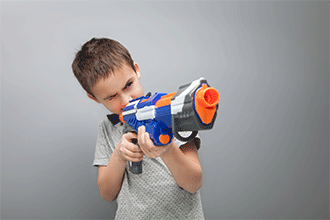Avoid these toys to prevent kids’ eye injuries

What child doesn’t like toys? And what parent or grandparent doesn’t enjoy buying a fun new toy for their young loved ones, particularly around the holidays?
But some toys that look really fun can pose a serious risk of eye injury — including serious injuries that can result in permanent vision loss.
Toys cause thousands of eye injuries every year
The U.S. Consumer Product Safety Commission estimates 231,700 children were seen in U.S. emergency departments in 2023 due to toy-related injuries.
Nearly half of these were “head and face” injuries, which include trauma to the eyes and area around the eyes. The same injuries represented more than 60% of total injuries to children under age 4.
Despite this, it can be easy to forget about eye safety when you’re shopping for toys.
Online surveys conducted by All About Vision revealed that
When choosing toys for their kids, 41% of parents said they “rarely” or “never” consider eye safety.
When asked whether any of their children’s toys could cause an eye injury, 54% of parents responded “definitely” and 22% said “possibly.”
What kind of eye injuries can a toy cause?
Common eye injuries caused by mishaps with toys can range from a minor scratch to the front surface of the eye (called a corneal abrasion) to very serious, sight-threatening injuries.

Aerosol string that hits the eye can cause a painful irritation of the eye called chemical pink eye.
Severe eye injuries can include the following:
Traumatic cataracts
Bleeding inside the eye
While some of these injuries can be treated, others can cause lifelong damage.
The “worst” toys of 2024-2025
World Against Toys Causing Harm (W.A.T.C.H.) is a nonprofit organization founded to protect children from toys that could cause physical harm. At the beginning of the holiday season each year, the group publishes a Top 10 list of the year’s “worst” toys, in terms of safety.
The lists can help parents make informed buying decisions during the 2024 holiday season and well into 2025. The next list of nominees will be released sometime before Thanksgiving 2024.
The 2024 nominees include three toys that could cause eye injuries in children:
Transformers Earthspark Cyber-Sleeve
What kid doesn’t want to pretend they’re battling Decepticons? While this toy blaster elevates imagination to a new level, it poses a serious risk of eye injury.
This toy doesn’t just come with Nerf darts that can injure the eyes, but another feature of the gadget includes a “sword” that is exposed with the swing of the user’s arm. The plastic sword comes to two sharp points at the end and can cause serious damage if it comes into contact with the eyes.
The product description says the toy is for ages 6 and up, and strongly advises wearing protective eyewear when in use.
X-Shot Poppy Playtime
Staying on the Nerf gun train, the X-Shot Poppy Playtime Dart Blaster is on W.A.T.C.H.’s “10 Worst Toys” list. This product has it all in regard to questionable features for a child’s toy.
For one, it has a double-barrel element that launches darts up to 90 feet. The power it takes to launch a Nerf dart that far requires pretty hefty force, which could cause significant damage if shot from close range.
The guns come with various “skins,” including an option called Jumpscare that features a sharp-toothed, wild-eyed creature that is nothing short of terrifying. Product listings for this toy advise it for children 3 and older, but the overall vibe seems more appropriate for older kids and teens.
Playzone-Fit Tri-Flyer
The Playzone-Fit Tri-Flyer isn’t as obvious of a threat as a dual-bladed sword flinging from your wrist, but still comes with its risks. With the goal of getting children to be more active indoors, the toy works as scooter or skateboard for young kids.
It’s a flat, plastic surface with silicone top to minimize slipping, and three 360° swivel wheels. The product advertises three ways for kids to use it: On their knees, on their bottom or on their stomach.
This toy certainly offers a more productive alternative to screentime when indoors. However, a product that encourages children to glide around the house head-first isn’t the safest gift you can give. If this is a must-have toy for your child, consider having them wear a helmet and safety goggles whenever they use it to avoid injury.
You can see the complete list of “worst toy” nominees on toysafety.org.
Other toys that pose a high risk of eye injury
Also consider this list of six types of toys you might want to cross off your list when buying gifts for young children. Each poses a high potential risk for eye injuries — especially if used by young children without adult supervision and guidance:

Guns that shoot ANY type of projectile. This includes toy guns that shoot lightweight, cushy darts. You might think these soft projectiles would pose little or no risk, but toy guns of this type can shoot up to distances of 75 feet. The darts move at speeds fast enough to cause a serious eye injury – especially when used at close range indoors.
Water balloon launchers and water guns. Water balloons can cause serious blunt trauma to the eye that can cause retinal detachment and lead to permanent vision loss. Even toy guns that shoot a stream of water can cause serious eye damage, especially when used at close range.
Games that include toy fishing poles. The end of a toy fishing pole or objects secured to the end of the fishing line can easily end up in a playmate’s eye.
Toy wands, swords, sabers or guns with bayonets. There’s really no need to explain why these are a bad idea, right?
Aerosol string. The chemicals in these products can cause eye irritation and a type of pink eye called chemical conjunctivitis. When used at close range, aerosol string can also cause a corneal abrasion that could lead to a serious eye infection.
Laser pointers and bright flashlights. Though technically not toys, many children love to play “laser tag” or “flashlight tag.” Portable laser pointers, like those used for business presentations, should never be used by children. The light intensity of these devices is enough to cause permanent vision loss. Even high-powered LED flashlights can be dangerous, because they can cause temporary blindness. This puts children at risk of a fall or other accident.
How to choose eye-friendly toys
If you are buying toys for grandchildren or the children of other relatives or friends, ask for suggestions from the child’s parents. Discuss any toys you’re thinking about purchasing to make sure the child’s parents are okay with the type of toy you’re considering.
It’s usually best to shop for children’s toys in a store rather than online. This helps you see the toy’s features up close to help you decide if it’s safe enough for a young child.
Toy packaging usually includes a recommended age range of children for whom the toy was designed. But keep in mind that these are general guidelines only. A toy that may be appropriate for one child may not be safe for another child of the same age. (It depends on their level of maturity and personality.)
Finally, when buying toys for older children, keep in mind that they may have younger siblings who could have access to the toys. It’s possible a new toy may not end up in the hands of the child you bought it for.
READ NEXT: More information about toys and eye safety
Toy-related deaths and injuries, calendar year 2023. U.S. Consumer Product Safety Commission. November 2024.
2024 "10 worst toy" list. World Against Toys Causing Harm. November 2024.
Page published on Tuesday, September 16, 2025
Page updated on Tuesday, December 10, 2024






